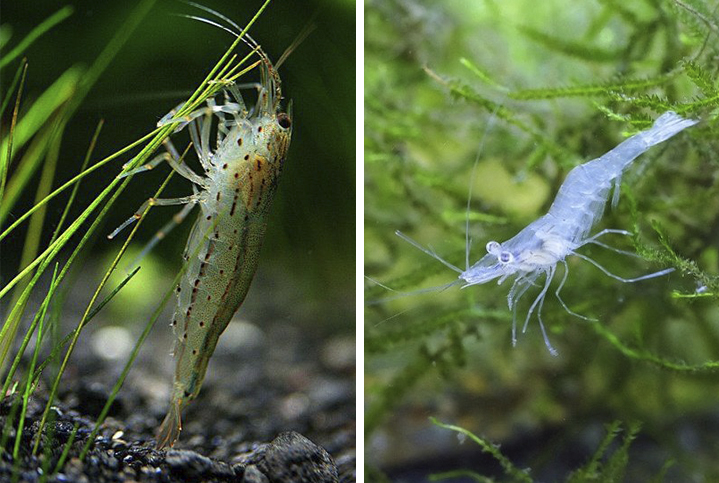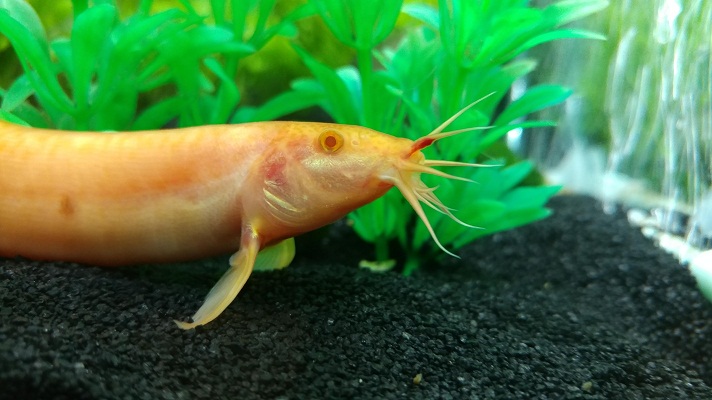

One of the most common fish characteristics is the scales that line their bodies. As such, it’s easy to conclude that all fish have scales which isn’t true. There are a couple of scaleless fish species available, some of which you can keep in your aquarium as pets. That said, some fish species look like they don’t have scales because the scales are too small to see with your naked eyes. As such, you shouldn’t rule out a fish just because it seems to have smooth skin. So, what fish don’t have scales? Before we can get to that, here’s an in-depth look at why some fish may or may not have scales.
Like other animals, fish have evolved and developed functional body parts over millennia, and the scales are just one example of that. In fact, according to Biology LibreTexts Trusted Source Fish Structure and Function These are the scales – the skin – of a blue Siamese fighting fish, and they almost look like a piece of art. They also look like they form a smooth, streamlined skin. Why is this important to a fish? bio.libretexts.org , the primary function of the fish scales is to provide protection. This includes protection from predators as they have a more challenging time biting into the hard surface of the scales.
Similarly, the scales provide protection from parasites. Also, given their overlapping design, they help reduce friction with water as the fish is swimming. So, what of fish with no scales? These fish have also evolved and adapted to their environment and thus have alternative methods to deal with predators, parasites, and the friction of swimming. Consequently, it’s safe to say that some fish don’t need scales.
As mentioned above, fish that don’t have scales have merely developed other means of protecting themselves. For instance, they may have a different material covering on their skin that is just as hard to penetrate as scales. One example is tiny teeth-like protrusions on the entire surface of the skin.
Alternatively, you may find lots of scaleless fish producing a thicker mucous layer to cover their skin, and this offers the necessary protection as most pathogenic organisms will find it challenging to burrow through. It may also prove effective against predators.
According to the Smithsonian Magazine Trusted Source 14 Fun Facts About Hagfish These frightening creatures defend themselves with slime and chow down on animal carcasse www.smithsonianmag.com , hagfishes which are a type of scaleless fish, use the slime and mucous they release to slip away and escape from predators. Additionally, the mucous protects the fish from friction while swimming.
Lastly, some fish have thicker skin which recovers from injury a lot more quickly; hence there’s no need for the scales.
Ultimately no scale fish are divided into the four main categories described below.
Chimaeriformes have soft elongated bodies, and the head is often bulky compared to the rest of the fish. Additionally, they have one gill opening on each side. Most chimeras can live up to 8500 ft below sea level and prefer to stay deep in the water. However, there are a few exceptions that may be found at depths of 660 ft or higher. These few exceptions can be kept in aquariums. That said, chimaeriformes can grow up to 4.9 ft long, so even the best 20-gallon fish tanks may not be enough if you plan to keep them.
In addition to being fish, Petromyzontiformes could also be referred to as parasites. This is because they attach to and feed off other fish with their jawless mouths. Notably, they also have rasping teeth that they use to bore into the bodies of the other fish.
As for Myxiniformes, their bodies are characterized by between 1-16 pairs of gills, horny suctorial teeth, diphycercal tails that extend from the vertebral column, poor eyesight, and no pectoral appendages. Despite having horny suctorial teeth like Petromyzontiformes, they don’t attach to or feed on healthy fish. Instead, their sustenance includes dead or dying fish. Lastly, Myxiniformes typically live on the ocean floor.
The latest research on Science Direct Trusted Source Phylogeny and classification of Neotropical fish In Siluriformes, a gelatinous coating (jelly coat) is observed covering the zona radiata in both the adhesive and nonadhesive eggs of the Pimelodidae and Loricaridae families. www.sciencedirect.com shows that Siluriformes mainly consists of freshwater fish with a few exceptions in the marine Ariidae and Plotosidae families. In addition to naked skin, they can have between 1-4 pairs of barbels which are whisker-like sensory organs on the head or near the mouth. Additionally, they have deeply embedded bony plates on their skin which may have protective functionalities.
For those wondering whether you can keep these fish in an aquarium, here’s a fish without scales list to consider depending on your resources, the size of the fish tank, and more. After all, some of these no-scale fish won’t fit in a 10-gallon fish tank while others might.
Despite being one of the ocean’s most deadly predator’s sharks are one type of fish with no scales that you can keep in your aquarium. In place of the scales, they have dermal denticles on their skin. These are teeth-like structures on the exterior of the fish.
Like scales, the dermal denticles are oriented towards the fish’s back to help reduce friction. The number of denticles also increases as sharks get bigger to ensure their whole body is covered.
That said, if you’re going to keep sharks at home, even a 55-gallon fish tank isn’t going to cut it. Sharks can grow quite big, so a 100-gallon tank or larger is ideal. Also, you might want to avoid putting sharks in the same aquarium as smaller fish species as they might be turned into food.
While whiptail stingrays maintain their soft skin, they aren’t defenseless. They use their spines for defense and can whip potential attackers with their tails hence the name. These tails feature barbed venomous spinal blades that puncture the assailants and cause severe pain. This is often an effective deterrent from attacks.
Whiptail stingrays are a great addition to a large aquarium, but if you keep them in the same tank as other aggressive fish, there will be multiple attacks. They also prefer sand in their environments to bury themselves. Additionally, they feed on fish and a few invertebrates on the ocean floor.
Their size is also worth mentioning. They can grow even past 6.56 ft across, so they will need a larger fish tank if you decide to keep them.
Catfish are Siluriformes and get their name from the whisker-like barbels around the fish’s mouth. While most species of catfish are freshwater fish, there are some like the gafftopsail catfish that prefer saltwater.
Also notable is that some catfish species prefer to sleep during the day and wake up at night. If you’re looking to keep some nocturnal fish, the Fluval Sea Evo Fish Tank comes highly recommended by users due to the included LED system for night illumination. It also features three-stage filtration for more transparent, cleaner water.
Additionally, catfish typically don’t mind sharing aquarium space with other fish species. So, for users looking to keep multiple fish species, reviewers recommend the Tetra 55 Gallon Aquarium Kit, which features a 55-gallon tank that provides more space for the fish. Additionally, it incorporates LED lighting and multiple other accessories, e.g., plants, a fishnet, heater, and more.
Lastly, some catfish species like the Asian Stone catfish are small, meaning you don’t need a large fish tank.
The vast majority of eels have slender, elongated bodies and look a lot like snakes. Some of these eels protect themselves by covering their bodies with a mucous layer that helps them slip away from other predators. Also, similar to the catfish, there are both freshwater and saltwater aquarium eels.
Eels can grow quite large, so depending on the species you want to keep, you might want to have a large rimmed or rimless aquarium. If you go for something like a moray eel for your aquarium, first ensure it’s large enough to accommodate the bulky size of the fish.
Secondly, get a sound filter system for your aquarium. Some of these scaleless fish produce lots of waste as they feed, and thus the filter system needs to be exceptionally robust; otherwise, the fish won’t last long. Avoid keeping eels with other fish species, and lastly, you need to be careful about the food you feed them. They can be picky, and some species like the moray eels prefer cold and frozen foods.
A few different species of rays are appropriate for fish tanks, although most of them won’t fit in regular aquariums due to their size. Some can even grow as large as six feet. Examples include electric rays, the whiptail stingrays mentioned above, and more. Before keeping any type of sea ray, it’s essential to study their ideal habitat. That way, you won’t end up killing the fish as they’re typically quite sensitive.
Electric rays are cartilaginous fish meaning their skeletons mainly consist of cartilage. Additionally, they have flattened bodies and come in different color schemes on their skin that can be very attractive to look at. Notably, they prefer to live in shallow parts of the ocean, which makes them ideal for aquariums.
Since they don’t have scales, their defense mechanism comes in the form of an electric shock, just like electric eels. However, according to Science and the Sea Trusted Source Shocking Differences Between Electric Animals | Science and the Sea Most people know that electricity and water don’t mix, but it’s not a problem for fish that produce their own electricity. The best-known electric fish is probably the electric eel, but it is far from the only “shocking” creature underwater. In fact, the electric eel, a single species that dwells only in the rivers of South America, is outnumbered by more than 60 species of www.scienceandthesea.org , the way they produce electric shocks is not the same. The eel has electric organs that it sends positively charged sodium through. This reverses the charge, with the result being an electric current.
On the other hand, electric rays have electrocytes which are modified muscle cells. These cells move ions through the cell membranes creating an electric discharge. The electric discharge can be used against both predators and prey.
Despite having this self-defense mechanism, electric rays are quite fragile. A knick on their skin can cause serious infections, which is why aquariums with electric rays shouldn’t have many decorative elements. Even the sand you use for the substrate should be extra fine.
As for skates, they might look a lot like regular stingrays, but there are a couple of notable differences as well. Their bodies are flat and either round or triangular. Additionally, their noses will protrude slightly from the rest of the body.
As for the differences, one major one is the lack of stings. Instead, you might notice some barbs alongside their spines which might extend to the tail. The fish uses these barbs for self-defense. That said, unlike stingrays, skates aren’t venomous and thus may be easier to handle.
Additionally, their tails come with small fins, not to mention they’re a bit stockier than those on regular stingrays. If you’re going to keep some skates in your aquarium, you should have a continuous supply of worms to feed them. They also eat shellfish.
So if you were wondering what fish don’t have scales that you can keep in your aquarium, the list above should provide a few good options. However, some of them are pretty big and require large aquariums, not to mention lots of resources to maintain. As such, the decision to keep them shouldn’t be made lightly.





